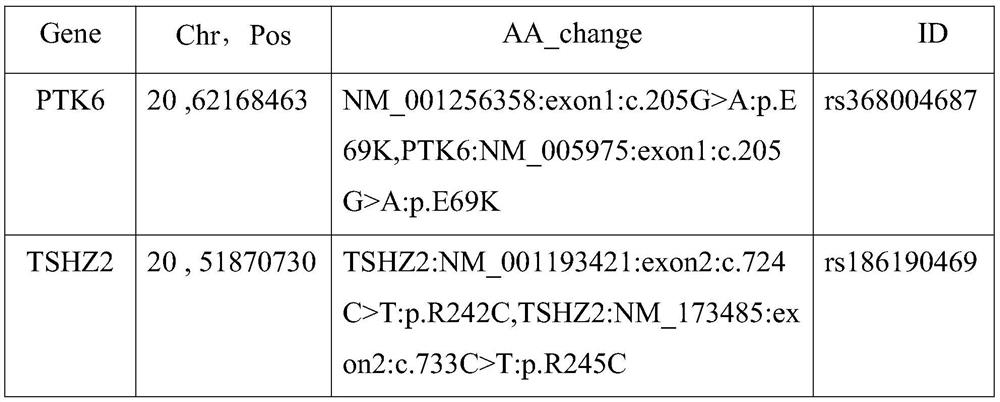SNP loci associated with aortic dissection disease and its application
A technology of aortic dissection and site, applied in the field of biomedical detection, can solve problems such as difficult early risk assessment, high AD vascular risk, and limited positive rate
- Summary
- Abstract
- Description
- Claims
- Application Information
AI Technical Summary
Problems solved by technology
Method used
Image
Examples
Embodiment 1
[0029] Example 1 Sample Collection
[0030] From January 2017 to April 2018, 99 patients with Stanford type A aortic dissection were diagnosed by aortic CTA in Sun Yixian Cardiovascular Hospital of Shenzhen, and 2 mL of whole blood and 590 normal control samples were collected from the database searched by Mykino Sequencing Company . The informed consent of the patients has been obtained and reviewed by the ethics committee.
[0031] Sample processing: Mix EDTA anticoagulated whole blood with Trizol at a ratio of 1:1, mix well and place in a 1.8mL cell cryopreservation tube, quickly cool in liquid nitrogen for 30s, and store in a -80°C refrigerator.
Embodiment 2
[0032] Example 2 Extraction of DNA from blood samples
[0033] (1) Add 1 mL of CL cell lysate to 1 mL of blood anticoagulated by EDTA (0.01M, China, Huamei Bioengineer), gently invert and mix 6 times, centrifuge at 3600 rpm for 5 min, and discard the supernatant;
[0034] (2) Pour 1 mL of CL cell lysate into the centrifuge tube again, gently invert and mix 6 times, centrifuge at 3600 rpm for 5 minutes, and discard the supernatant; on the premise of ensuring that the precipitate remains in the tube, invert the centrifuge tube in Let stand on clean absorbent paper for 2min;
[0035] (3) configure the mixture of proteinase K and buffer FG;
[0036] (4) Add 500 μL of the mixture of proteinase K and buffer FG, and then mix until the solution has no clumps;
[0037] (5) 65℃ water bath for 30min, invert and mix several times during this period;
[0038] (6) Add 1 mL of isopropanol, then invert and mix until clustered or filamentous genomic DNA appears;
[0039] (7) Centrifuge at ...
Embodiment 3
[0047] Example 3 Whole exome sequencing
[0048] 1. DNA library construction
[0049] 3 μg of DNA was fragmented by ultrasonic, the ends of the fragments were blunted, A was added at the 3' end, and the adaptor was connected, and fragments between 350 and 400 bp were selected to prepare a whole genome library. The library samples were quality controlled using an Agilent 2100 Bioanalyzer (Agilent Technologies, USA).
[0050] 2. Target region capture and sequencing
[0051] Whole exome detection was performed using GenCap liquid phase capture target gene technology (Beijing Mykino Co., Ltd.). Mix 1 μg of DNA library with BL buffer and probe, heat at 95 °C for 7 min, and heat at 65 °C for 2 min, add 23 μL of HY buffer preheated to 65 °C, and hybridize at 65 °C for 22 h. 50 μL of MyOne magnetic beads (Life Technology, USA) were washed 3 times with 500 μL of 1X binding buffer, and resuspended in 80 μL of 1X binding buffer. Add 64 μL of 2X Binding Buffer to the hybridization mix...
PUM
 Login to View More
Login to View More Abstract
Description
Claims
Application Information
 Login to View More
Login to View More - R&D
- Intellectual Property
- Life Sciences
- Materials
- Tech Scout
- Unparalleled Data Quality
- Higher Quality Content
- 60% Fewer Hallucinations
Browse by: Latest US Patents, China's latest patents, Technical Efficacy Thesaurus, Application Domain, Technology Topic, Popular Technical Reports.
© 2025 PatSnap. All rights reserved.Legal|Privacy policy|Modern Slavery Act Transparency Statement|Sitemap|About US| Contact US: help@patsnap.com



